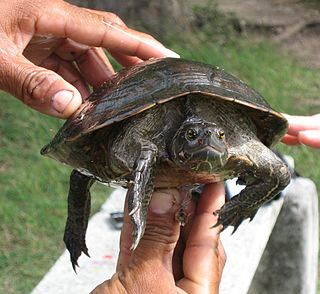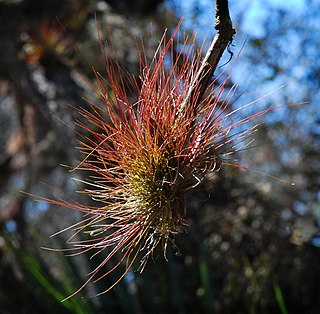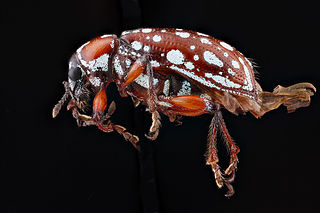
The Greater Antilles is a grouping of the larger islands in the Caribbean Sea, including Cuba, Hispaniola, Puerto Rico, Jamaica, Navassa Island, and the Cayman Islands. Six island states share the region of the Greater Antilles, with Haiti and the Dominican Republic sharing the island of Hispaniola. Together with the Lesser Antilles, they make up the Antilles, which along with the Lucayan Archipelago, form the West Indies.

Psidium is a genus of trees and shrubs in the family Myrtaceae. It is native to warmer parts of the Western Hemisphere. Many of the species bear edible fruits, and for this reason several are cultivated commercially. The most popularly cultivated species is the common guava, Psidium guajava.

The fauna of Puerto Rico is similar to other island archipelago faunas, with high endemism, and low, skewed taxonomic diversity. Bats are the only extant native terrestrial mammals in Puerto Rico. All other terrestrial mammals in the area were introduced by humans, and include species such as cats, goats, sheep, the small Indian mongoose, and escaped monkeys. Marine mammals include dolphins, manatees, and whales. Of the 349 bird species, about 120 breed in the archipelago, and 47.5% are accidental or rare.

Pseudophoenix is a genus of palms which is native to the wider Caribbean. Three species of the four species are endemic to Hispaniola, while the fourth, P. sargentii, is widely distributed in the northern Caribbean, Florida, and the Yucatán Peninsula.

The Central Antillean slider is a species of turtle in the family Emydidae. The species is found on three islands in the West Indies: Hispaniola, Great Inagua, and Puerto Rico.

Forestiera is a genus of flowering plants in the olive family, Oleaceae. Members of the genus are often called swampprivets. Most are shrubs.
The Caribbean bioregion is a biogeographic region that includes the islands of the Caribbean Sea and nearby Atlantic islands, which share a fauna, flora and mycobiota distinct from surrounding bioregions.

Roystonea borinquena, commonly called the Puerto Rico royal palm, is a species of palm which is native to Hispaniola, Puerto Rico and the Virgin Islands.

Quararibea turbinata, also known as the swizzlestick tree, is an aromatic plant native to such Caribbean locales as Antigua, Barbados, Dominica, Grenada, Guadeloupe, Hispaniola, Martinique, Montserrat, Netherlands Antilles, Puerto Rico, St. Kitts and Nevis, St. Lucia, Saint Vincent and the Grenadines and the Virgin Islands. It is generally described as a perennial tree or shrub and its common name comes from its use as a swizzle stick and its association with cocktails such as the Rum Swizzle.

Lasiacis (smallcane) is a genus of Neotropical plants in the grass family, found in the Americas from Mexico and Florida south to Argentina.

Sphagneticola is a genus of flowering plants in the family Asteraceae. Creeping-oxeye is a common name for plants in this genus.
Catopsis nitida is a species in the genus Catopsis. This species is native to southern Mexico, Central America, Cuba, Hispaniola, Jamaica and Puerto Rico.
Catopsis nutans is a species in the genus Catopsis. This species is native to Florida, Central America, Greater Antilles, Venezuela, Colombia, Bolivia, and Ecuador.

Tillandsia setacea, the southern needleleaf, is a species of flowering plant in the genus Tillandsia. It has a scattered, disjunct distribution in the southeastern United States, northwestern and southern Mexico, Guatemala, the West Indies and the State of Pará in northeastern Brazil.
Ilex urbaniana, known commonly as the Urban's holly, is a species of tree or shrub in the Aquifoliaceae or holly family of flowering plants. It is found on Hispaniola, Puerto Rico, and the U.S. and British Virgin Islands.

The Taíno were a historic Indigenous peoples of the Caribbean, whose culture has been continued today by Taíno descendant communities and Taíno revivalist communities. At the time of European contact in the late 15th century, they were the principal inhabitants of most of what is now Cuba, the Dominican Republic, Jamaica, Haiti, Puerto Rico, the Bahamas, and the northern Lesser Antilles. The Lucayan branch of the Taíno were the first New World peoples encountered by Christopher Columbus, in the Bahama Archipelago on October 12, 1492. The Taíno spoke a dialect of the Arawakan language group. They lived in agricultural societies ruled by caciques with fixed settlements and a matrilineal system of kinship and inheritance. Taíno religion centered on the worship of zemis.
Haenianthus is a genus of plants native to the Greater Antilles of the Caribbean. It contains 3 species:
- Haenianthus incrassatus(Sw.) Griseb. - Jamaica
- Haenianthus salicifoliusGriseb. - Cuba, Hispaniola, Puerto Rico
- Haenianthus variifoliusUrb. - Cuba

Lachnopus is a genus of broad-nosed weevils in the family Curculionidae distributed in the Caribbean Region.














